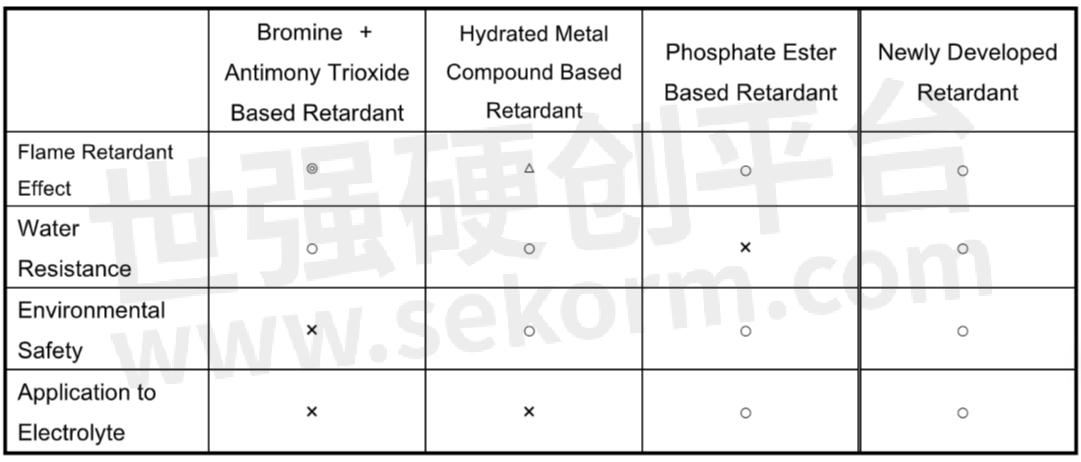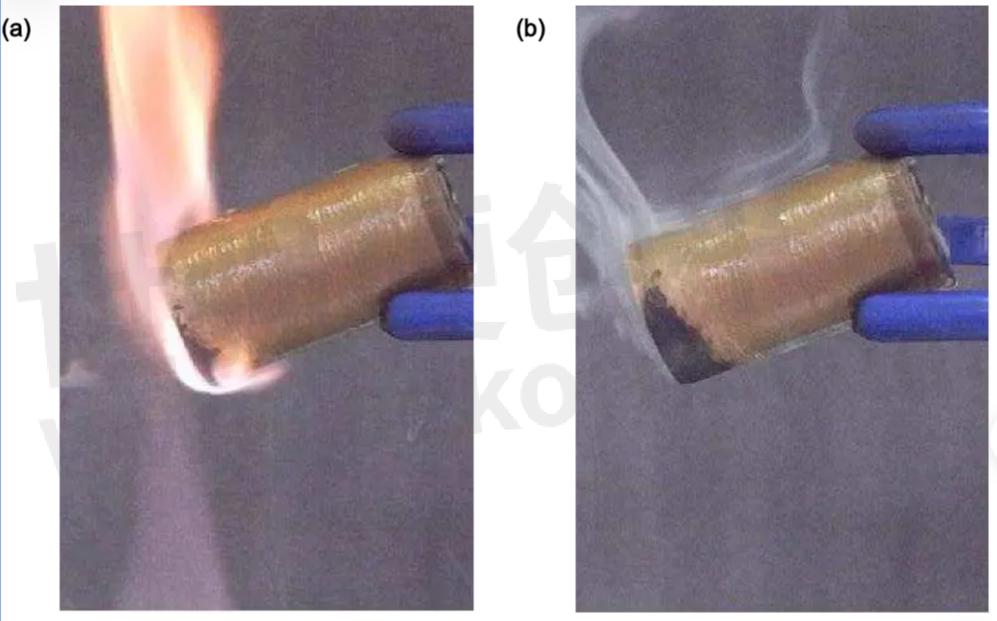Nippon Chemi-Con Developed Electrolyte Flame Retardant Technology Application to High Voltage Aluminum Electrolytic Capacitors
Nippon Chemi-Con has succeeded in developing a technology to make the electrolyte of Aluminum electrolytic capacitors flame resistant by using a flame retardant with greatly suppressed hydrolyzing properties. By applying this flame retardant technology, it has become possible to maximize the potential of high voltage aluminum electrolytic capacitors with excellent low-temperature characteristics.
For aluminum electrolytic capacitors, since an organic solvent is used in the electrolyte inside the capacitor element, there is a fear that this electrolyte might catch fire if a short circuit occurs due to circuit failure, etc.
In order to prevent this, Nippon Chemi-Con has been researching the use of an electrolyte to which a flame retardant has been added. While there are various flame retardants available as shown in Table 1, after considering environmental safety and upon joint investigations with chemical manufacturers, Nippon Chemi-Con succeeded in developing a new flame retardant with a structure that is resistant to hydrolysis.
The results of verifying the flame retarding properties of the aluminum electrolytic capacitors are shown in the photos below (Fig. 1 (a) and (b)). These photos show an aluminum electrolytic capacitor element after being exposed to a gas burner flame for 10 seconds and the flame was removed.
While the capacitor continues to burn even after the burner is taken away in the case of an ordinary aluminum electrolytic capacitor, the fire goes out immediately when the flame of the burner is taken away and the aluminum electrolytic capacitor element does not catch fire in the case of the aluminum electrolytic capacitor with the newly developed flame retardant. Thus Nippon Chemi-Con could confirm the fire retardant effect of the electrolyte containing the newly developed flame retardant.
In addition, when the hydrolyzing properties are compared with the commonly used phosphate ester-based flame retardant, while the residual amount of flame retardant was 0% after 2,000 hours at 135℃ in the case of the conventional flame retardant, it became clear that almost 100% of the newly developed flame retardant remained after a similar experiment.
Because of this flame retardant technology, it has become possible to use a solvent that was previously difficult to use in relatively flammable conditions and to develop an electrolyte for a high voltage capacitor with excellent low-temperature characteristics. Using this electrolyte Nippon Chemi-Con would be investigating products that can be used in very severe low-temperature conditions, such as for example, in the power supplies or lighting inverter applications used inside a freezing warehouse, etc.
Table 1 Common Types of Flame Retardant

Fig. 1 Results of Flame Retardant Effect Test.
(a) Aluminum electrolytic capacitor element with electrolyte being exposed to gas burner flame.
(b) One second after the gas burner was taken away from the element.

- +1 Like
- Add to Favorites
Recommend
- Nippon Chemi-Con Developed HXF Series Conductive Polymer Hybrid Aluminum Electrolytic Capacitors with 2.1 Times Higher Ripple Current
- Conductive Polymer Hybrid Aluminum Electrolytic Capacitor Development of the “HXJ (125℃)/HXK (105℃) Series“ That Provide One Rank Higher Capacitance in the Same Size
- Nippon Chemi-Con Developed High Ripple Resistant Screw Terminal Type Aluminum Electrolytic Capacitors RWJ Series with 1.16 Times Higher Ripple Resistance
- Nippon Chemi-Con Developed RWU/RWX Series High-Capacitance Screw Terminal Type Aluminum Electrolytic Capacitors with 50% Higher Capacitance
- Nippon Chemi-Con Added High Withstand Voltage Products with 550V Rated Voltage LXS Series Snap-in Type Aluminum Electrolytic Capacitors
- Nippon Chemi-Con GOB, MXB and HSF Sereis Aluminum Electrolytic Capacitors with an Upper Category Temperature of 150℃
- Exxelia Unveils Innovative Aluminum Electrolytic Capacitors to Save Room and Weight for Energy Function
- Nippon Chemi-Con Added PMA Series Resin-Molded Chip Type Conductive Polymer Aluminum Solid Capacitors With a Low Profile of 3.0mm
This document is provided by Sekorm Platform for VIP exclusive service. The copyright is owned by Sekorm. Without authorization, any medias, websites or individual are not allowed to reprint. When authorizing the reprint, the link of www.sekorm.com must be indicated.





























































































































































































































































































































































































































































































































































































































































































































































































































































































